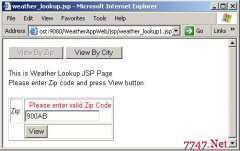jsp template之我见
来源:未知 责任编辑:责任编辑 发表时间:2013-11-18 20:56 点击:次
我们在做程序的过程中,常常会遇到这样一种情况,就是在一个项目中,会发现有很多页面的框架基本相同的,只是具体显示的内容不同,而按常规的做法,我们可能会用include语句来提出框架内容,然后在每个页面中引用这些框架,但这样就会产生一个问题,如果我的框架发生变化了,那应该怎么办呢?举个例子,一个index.jsp(SUN企业级应用的首选)可能包含有head.jsp(SUN企业级应用的首选)和foot.jsp(SUN企业级应用的首选)。而其它页面也同样包含这两个jsp(SUN企业级应用的首选)。但如果我在index.jsp(SUN企业级应用的首选)里有一段导航条的代码,我现在想在每个页面里引用,而不想加到head.jsp(SUN企业级应用的首选)中,难道我们要在每个页面里都增加这个导航条的代码吗?我想我是不会这样做的。因为有一种更好的办法来解决这种问题。那就是采用模板页面。
template页面的原理,其实就是写一个servlet来实现页面的跳转,然后在web.xml(标准化越来越近了)里面配置这个servlet,使要使用模板的这一类jsp(SUN企业级应用的首选)文件,都通过这个servlet来处理,使它们都转到模板页面即可。然后在模板页面中include这些页面的内容页即可。
具体的做法,只要写一个template.jsp(SUN企业级应用的首选)做为模板页面、一个TemplateDispatch.java做为跳转的类就可以了。然后在调用时,直接指向这个SERVLET,加一个参数,说明要用到哪个内容页就行了。写个简单的例子如下:
template.jsp(SUN企业级应用的首选)
=====================================
<% page contentType="text/html; charset=gb2312"%>
<%@ include file=“head.jsp(SUN企业级应用的首选)“%>
<%=(String)request.getAttribute(“body“)%>
<%@ include file=“foot.jsp(SUN企业级应用的首选)“%>
TemplateDispatch
=====================================
public class TemplateDispatchextends HttpServlet{
public void doGet(HttpServletRequest request,HttpServletResponse response){
doPost(request,response);
}
public void doPost(HttpServletRequest request,HttpServletResponse response){
HttpSession session = request.getSession(true);
session.setAttribute(“body“,“index.jsp(SUN企业级应用的首选)“);
RequestDispatcher rd = session.getServletContext().getRequestDispatcher("template.jsp(SUN企业级应用的首选)");
rd.forward(request,response);
}
}
web.xml(标准化越来越近了)
=====================================
<servlet>
<servlet-name>dispatch</servlet-name>
<servlet-class>TemplateDispatchextends </servlet-class>
</servlet>
<servlet-mapping>
template页面的原理,其实就是写一个servlet来实现页面的跳转,然后在web.xml(标准化越来越近了)里面配置这个servlet,使要使用模板的这一类jsp(SUN企业级应用的首选)文件,都通过这个servlet来处理,使它们都转到模板页面即可。然后在模板页面中include这些页面的内容页即可。
具体的做法,只要写一个template.jsp(SUN企业级应用的首选)做为模板页面、一个TemplateDispatch.java做为跳转的类就可以了。然后在调用时,直接指向这个SERVLET,加一个参数,说明要用到哪个内容页就行了。写个简单的例子如下:
template.jsp(SUN企业级应用的首选)
=====================================
<% page contentType="text/html; charset=gb2312"%>
<%@ include file=“head.jsp(SUN企业级应用的首选)“%>
<%=(String)request.getAttribute(“body“)%>
<%@ include file=“foot.jsp(SUN企业级应用的首选)“%>
TemplateDispatch
=====================================
public class TemplateDispatchextends HttpServlet{
public void doGet(HttpServletRequest request,HttpServletResponse response){
doPost(request,response);
}
public void doPost(HttpServletRequest request,HttpServletResponse response){
HttpSession session = request.getSession(true);
session.setAttribute(“body“,“index.jsp(SUN企业级应用的首选)“);
RequestDispatcher rd = session.getServletContext().getRequestDispatcher("template.jsp(SUN企业级应用的首选)");
rd.forward(request,response);
}
}
web.xml(标准化越来越近了)
=====================================
<servlet>
<servlet-name>dispatch</servlet-name>
<servlet-class>TemplateDispatchextends </servlet-class>
</servlet>
<servlet-mapping>
相关新闻>>
- 发表评论
-
- 最新评论 进入详细评论页>>


